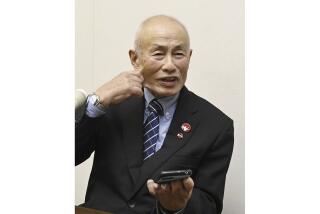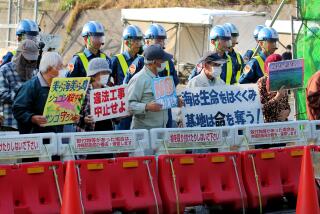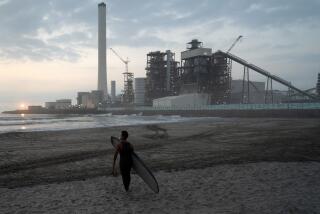A-Bomb Victims Are Also Survivors : Radiation: Many have suffered severe illnesses. Many also have lived long lives, outliving American counterparts.
NAGASAKI, Japan — Some of the children whisper and fidget as the old man begins his story. “I was one of the lucky ones,” Masakatsu Obata says in a raspy voice to the 70 fifth-graders in red caps and blue skirts and knee pants. “I was inside a building at the factory where I worked. I thought I was going to die, but I didn’t.”
The youngsters are gathered in the shade of an outdoor pavilion. Nearly 50 years ago this was ground zero--the spot where the world’s less-remembered atomic warhead exploded overhead killing or injuring about 75,000 people.
Obata, now 80, was a mile away on that chilly August morning in 1945--three days after Hiroshima--when a more powerful American bomb scorched Nagasaki. The city’s hilly terrain protected it from devastation like Hiroshima’s.
A brilliant blue-white light flashed across the assembly floor of the Mitsubishi munitions plant. Obata had been about to go outside to eat the lunch his wife had packed.
He was burned and badly shaken, but shielded from serious injury.
His wife wasn’t so lucky. She and their two children were caught on a hillside near their house. A chunk of debris, possibly a roof tile, blew through her chest like a cannonball. All died, Obata hopes, instantly.
The cries for help of those who lived longer still haunt the “hibakusha,” today’s approximately 360,000 survivors of the two bombings that were destined to end World War II.
About 62,400 of these survivors, part of a group that numbered 120,000 in 1950, have been included in a long-term study that is now in danger of being curtailed or halted because of funding problems. Supported by both the U.S. and Japanese governments, it has analyzed radiation’s aftermath over decades.
At present, most of the hibakusha are living relatively normal lives--statistically longer than Americans--according to Dr. Mortimer L. Mendelsohn, vice chairman of the Radiation Effects Research Foundation, based in Hiroshima.
As many as 210,000 people had died by the end of 1945. Eighty-five percent were 30 or younger. Those who survived the initial effects of the heat and blast seemed to regain health at first. But other symptoms soon set in, mostly associated with exposure to the gamma rays and neutrons emitted within a minute of the explosion, and to a small extent from residual radiation that lasted for nearly a week afterward.
Over the years, many hibakusha have been plagued with severe illness.
“Leukemia began increasing a few years after the bombing,” Mendelsohn said. “It peaked six or eight years afterward, then trickled off.”
At first there was no change in the cancer rate. But, beginning about 1950, more people began developing malignant tumors of all types.
Thus far, children of the hibakusha seem largely unaffected. But women who were pregnant when the bombs fell have given birth to children who grew less, had abnormally small heads and, in severe cases, were mentally retarded.
In 1957 the Japanese government, which had renounced all claims against the United States as part of the treaty ending the war, set up a medical care program that included treatment for bomb-related injuries and sickness.
A later government program provides special financial allowances to victims. The municipalities of Hiroshima and Nagasaki, and several private groups, have established hospitals, nursing homes and recreational facilities.
The hibakusha themselves have formed groups, which were brought together in 1956 by the Japan Confederation of A- and H-Bomb Sufferers Organizations, or Hidankyo.
The United States and many other governments use the research foundation’s four-year updates as a basis for setting radiation exposure standards for workers, for the environment and for patients receiving radiological treatments or tests, such as chest X-rays, mammograms and radioactive iodine used to measure thyroid function.
“This is the only sizable population in the world where we have known individual exposure doses and can follow people throughout their lives and see what the effects are,” said Mendelsohn. “It’s important to keep going.”
“The information is especially important for assessing radiotherapy treatments for childhood cancer, since children may be more vulnerable to radiation,” said John D. Zimbrick of the National Academy of Sciences, which manages the American half of the research. “We won’t know the answer for another 10 years.”
Such standards are also applied to medical technicians who administer these procedures and military personnel working around nuclear weapons or aboard nuclear-powered submarines. They also help predict risk levels for victims of accidents such as the 1986 explosion at the Soviet Chernobyl nuclear power plant.
When joint operation of the foundation began in 1975, the United States and Japan agreed to split the costs evenly.
But the most recent devaluations of the dollar and across-the-board cuts in government spending have produced, according to one projection, a 25% cut in U.S. funding from the fiscal year 1994 level of $18 million.
Japan has threatened to cut its contribution by an amount equal to any U.S. cut. But in a series of negotiations, the United States is pressing the Japanese to pick up more of the expenses.
“We hope they can work out something that will prevent a train wreck,” said Zimbrick.
More to Read
Sign up for Essential California
The most important California stories and recommendations in your inbox every morning.
You may occasionally receive promotional content from the Los Angeles Times.










